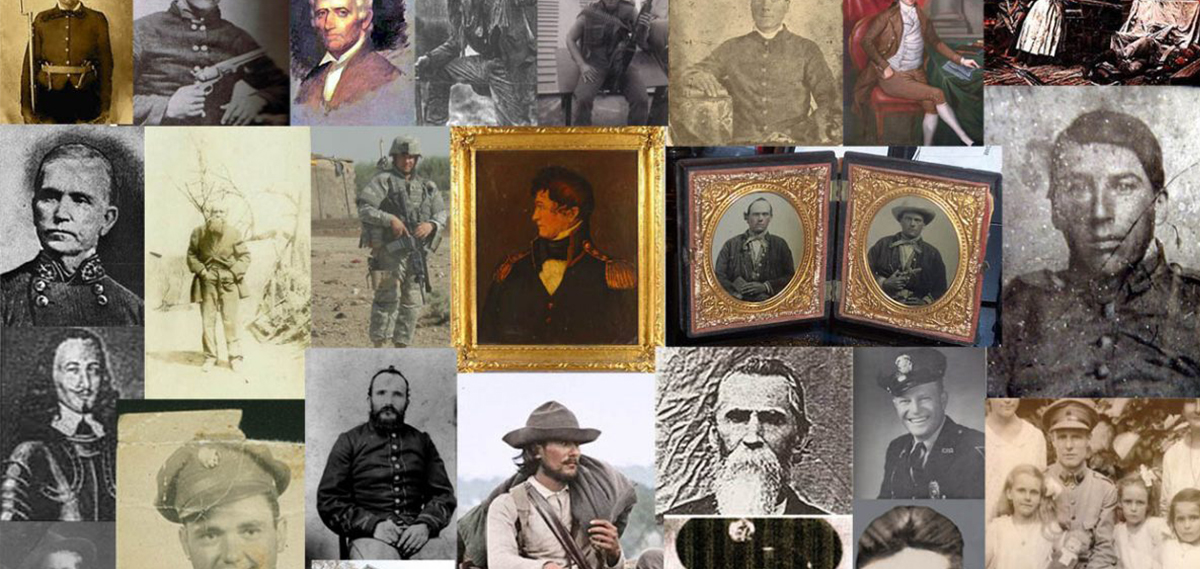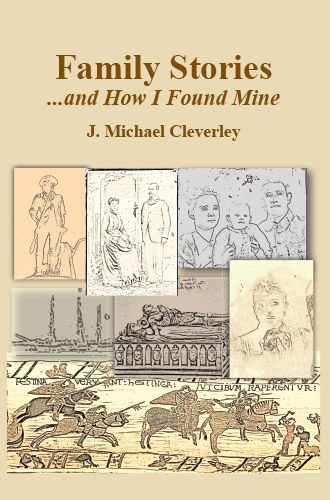
Family Stories . . . and How I Found Mine, Chapter 7: Soldiers, Survival, Sorrow, by J. Michael Cleverley
In the September 15 issue of “Genealogy Pointers,” we traced author J. Michael Cleveley’s ancestors to Rhode Island on the eve of the American Revolution, as they attempt to organize a militia company to support the Patriot cause. Nearly a century later, we learn that those Rhode Islanders’ descendants are struggling to establish themselves on farms in Vernon County, Missouri, contending with disease, misfortune, and marauding bands on either side of the slavery issue. We also learn that the author was able to unearth some—but not all—of the facts surrounding his forebears’ vicissitudes from probate records. View Book Details
“Soldiers, Survival, and Sorrow,” by J. Michael Cleverley
When Chester and Susannah bought the new farm, the place was freshly settled frontier. It was situated in a fairly remote northern part of Vernon County [in western 1850s Missouri]. The first White settlers had been there only 25 years, and the county, itself, was barely two years old. It did not have a jail, and a courthouse was under construction in a town named Nevada [pronounced: Ne-vay’-da] City, in the center of the county…1
1 Howard L. Conard, ed., Enclyclopedia of the History of Missouri, VI, (St. Louis: The Southern History Company, 1901), 296-297.
The Lents paid $1,470 for their 220 acres. The land was situated in a place that today is called the Four Rivers Area, the watershed of the Osage, Little Osage, Marais de Cygnes, and Marmaton Rivers. Near their home, the Osage River wound its way over the flat prairie to join the Marmaton River and Muddy Creek. The rivers contributed to an expanse of wetlands that made a home for abundant wildlife. In addition, their farmyard was well stocked with livestock. Three steers, two cows, four calves, and ten hogs (and probably horses, cats, dogs, and chickens) all roamed the corrals and pastures. They probably picked up some of the farm animals after arriving from Indiana, but perhaps they brought some with them. Chester and Susannah took a mortgage to pay for their new home.2
Maybe at another time and place, their start would have been a good one. Not long after taking up their new Missouri home, however, Chester died suddenly. The timing was devastating: new farm, new community, and young family. Among all the files, remembrances, and documents Mother and other relatives collected, there is no documented mention of exactly when or how Chester died. Over the years there were family stories and speculation that he was murdered in the cross-border raids. It is one of those traditions that is at least feasible, but most victims of the brutal forays were noted one way or another in county and other histories. There appears to be no mention of Chester’s death in any newspapers or document, except the probate records that are also silent on the date and cause.
Susannah was left a widow with small children and a farm for which they owed money. On the American frontier there was never room to take much pause even to mourn tragedy and death. Life had to go on in a world that was often hostile and violent; there was simply too much work for anyone to stop. Susannah’s oldest son, John William, at 20, was old enough to take some responsibility. The two oldest daughters got married during the following months. Mary Elizabeth wed a young man named Richard (Dick) Parmenter. Eighteen-year-old Maria married James Williams on the 4th of July 1860…3
Family tradition says that they tried to be on neither side of the slavery issue, but their neighbors would have considered them “northerners” at a time when everyone was labeled one way or another. …trying to keep a low profile did not help when the vast majority of the people of the county were secessionists. During the presidential election of November 1860, no votes for Abraham Lincoln were recorded in Vernon County. It has been said there were a dozen people in the county who would have voted Republican, but officials made each voter declare whom they supported before casting their ballot. Lincoln supporters did not get to vote. 4
2All livestock mentioned in “Property Appraisal, Probate Records for Chester Lent,” loose, February 14, 1859, Probate Records for Vernon County, Missouri, located in the Bushwhacker Museum, Nevada, Missouri, photocopies in my possession. Deed Records, dated July 17, 1857, for purchase of 200 acres from purchased from John Waldrop in Vernon County, MO, copy in my possession.
3Family Records of Margie Lea Leonardson Cleverley and Peggy Ann Lent, copies in my possession.
4James R. Baker, Bushwhackers! A Civil War History of Vernon County Missouri, Kindle edition, download from Amazon.com, Chapter 2.
It was about this time that raiders from one side or the other rode onto the Lent farm. They appeared in the distance and continued directly toward the farmhouse. It meant danger and struck fear in all of them. The smaller children ducked into barrels. Mary’s young husband Dick came out to meet them. The raiders said they wanted food and whatever else they could have. Dick refused. Following Chester’s passing, the Lents probably had little to surrender. One of the raiders raised his gun, pointed the barrel at Dick, and growled a threat to shoot him dead.
Before he could follow through, the boss of the band stopped his gunman. Then happened what became a common Civil War practice during the years to come. When local farm and plantation owners did not give raiding parties the provisions they demanded, the foragers burned them out. The gunmen torched Susanna’s home and burnt it to the ground. Her family had little before, and now not even that. That night Susanna and her children moved into the small home of Mary Elizabeth and her husband Dick.5
5From a family history in possession of Peggy Lent and also recorded in a family history entitled “Robison Lent and the LENT family,” by Freda F. Marsh, written in 1963.
Probate Records Hold Many Stories
With a solution to the question of Chester’s origins, there remained when and how he died. One spring I decided to travel to the Kansas-Missouri border to find out. Seija, one of our sons, and his small six-year old daughter, Mia, joined this family history expedition. We flew to Kansas City, rented a car, and then drove south toward Nevada City. It was immediately clear that the highlight of our three-generation adventure was not just what we might find in the fields and town streets of Missouri. The real joy came from doing it together. It was a reminder that in family history, the emphasis is on the first word, “family.” Linking present family to those of the past is what it is about…
Before leaving home, I had phoned the Bushwhacker Museum in Nevada, Missouri, to make an appointment with one of the museum’s curators. We were scheduled to be there on a Saturday, off-tourist season. I wanted to be sure it was open and that someone knowledgeable would be there. In our phone conversation, I learned that the Museum had charge of Vernon County’s historical records. All the better. A curator named Will kindly agreed to meet us during our visit.
My wife, son, and little Mia wandered the museum’s colorful displays telling of the county’s tumultuous history while Will listened to me tell Chester’s story. After I explained to him what I was looking for, he disappeared into the back room. I was astonished when he returned with two file folders hand labeled, “Chester Lent.” They contained the original probate documents from Chester’s estate.
These were some of those records spirited out of Vernon County by the southern-sympathizing county clerk. They were stashed somewhere while the man served with the Confederates. After the war, they somehow were brought back home. While I combed through them, Will went through other files and newspaper indexes to see what he might find. Unfortunately, there were no further references to Chester Lent. In fact, there was no newspaper in Nevada City until well after Chester’s family left for Kansas.
While sifting through the two files of documents, inventories, and receipts, one piece of paper caught my eye – an account from a Dr. Curt Boettinger who billed Chester 19 times for “Attendance and Medicine” from August to October, 1857. Once, this frontier doctor also noted giving care to a “daughter.” We knew their youngest daughter, Sarah, had died sometime during or immediately after the move to Missouri, but not exactly when. Perhaps the daughter on this billing was Sarah.
The next day in September, Boettinger again billed for care to a “child,” perhaps the same one. The following week he charged them extra to work during the night. A doctor’s night call on the frontier suggested something very serious. There were two more charges for the child, and the rest were for someone else not noted, perhaps Chester.
This was all during the first months after they moved to their new Missouri farm. One can easily imagine one or another of the many diseases common in 19th century America inflicting them. But by the end of 1857, the doctor was billing Chester for a sack of flour he sold him on November 7. So Chester was still alive at that time.
Then, on February 10, 1859, just over a year later, Susannah signed a receipt for the sale of belongings from Chester’s estate: a rifle, saddle, 10 pigs, calves, a steer, and so on. It was clear that Chester died between November 1857 and February 1859, almost certainly sometime in 1858. So, we at least had narrowed Chester’s death date to a matter of months.
There had always been a family tradition that Chester might have been killed by one of the marauding bands of raiders. However, the museum curator told me that there were few jayhawker incursions into Vernon County in 1858, and he believed a death associated with a raid would have been recorded. We knew that John Brown led a murderous foray into the area around the Lent farm in December 1858, but the raid and his victims were well documented. Chester Lent was not among them.
Will agreed with my thought that probably Chester was taken by illness, disease, or a serious accident. The doctor’s many visits to their home during late 1857 show that someone or several of them must have been seriously ill. So we could deduce about when he died, and the most likely cause. The full details of Chester’s death remained only in the memories of his family, however, and those, too, are long gone.




